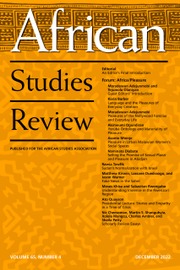“Rwanda was filled with corpses, with survivors, with perpetrators … with violence—and with law” (293). This quote perhaps sums up the arguments portrayed in this six-part, twelve-chapter book. Meierhenrich delineates “lawfare” by tracing pre-formation legal conditions to the deformation of Gacaca courts in postapartheid Rwanda. This book is a page turner that challenges certain views pertaining to the transitional justice mechanism inherent in Inkiko Gacaca courts which Meierhenrich describes as “an example of lawfare” (42).
Part One fills the gap in literature by carrying out a comprehensive analysis of the institutional development of Gacaca courts and provides a worthy introduction to the formation of the Inkiko Gacaca as a tool of transitional justice which the author refers to as “an apparatus of governmental violence” (66). This serves as a viable foundation for Part Two, which engages theoretical analysis and conceptualization of lawfare, legalism, and legal rule. The author draws attention to lawfare techniques such as executive, legislative, judicial, constitutional, and administrative violence. As such, the violence of law is not limited to physical violence but includes variations of economic, social, emotional, and legal.
In exploring the emergence of lawfare, Meierhenrich juxtaposes pre- and post-genocide legal frameworks and sheds light on the visibility of lawfare in courts, prisons, and punishment practices. The puzzling involvement of the authoritarian government in the implementation of judicial policies and transitional justice mechanisms in Rwanda is widely discussed. This is accurately done by analyzing the government’s legal policies, the role of chambres spécialisées, and the effects of prosecution on transitional justice. These legal violent policies not only affected Rwandans but also affected Rwandan institutions.
In the largest part comprising of Chapters Five to Nine, the author does a deep dive into the evolution of lawfare by exploring the varieties of Gacaca courts. The author details citizens’ reactions to the introduction of Inkiko Gacaca as well as its imposition as a reconciliation mechanism. The locals reacted with a certain level of apathy, silence, distrust, reluctance to the forced participation, bribery, and intimidation. As such, the authoritarian regime marketed a solution for which there was no demand. An under-explored theme is the extent of the influence of ethnic discord (Hutus and Tutsis) on the legal implementation and the effectiveness of transitional justice mechanisms. With the Inkiko Gacaca introduced in 2002, these chapters explore four institutional processes—modernization, legalization, bureaucratization, and sensitization. The inclusion of audio transcripts of pre-Gacaca proceedings made it more practical and engaging. Also, Meierhenrich counters the notion that the Inkiko Gacaca was intrinsically a traditionally created mechanism, as elements of Inkiko Gacaca are more modern than traditional. In the author’s augments, a central point is that the Inkiko Gacaca was not transitional justice but a stimulator that was more imagined than real. More importantly, the Kagame presidency was hypocritical as it portrayed the promotion of transitional justice mechanism while the political administration was popular for its widespread violent acts under the pretext of punishment. In essence, the “Inkiko Gacaca was just another repressive institution—an institution of injustice” (429). Perhaps there were more efforts geared towards marketing Inkiko Gacaca as a transitional mechanism than to ensuring its effectiveness. Such marketing mediums are visible in international involvement through foreign aids, promotion on media platforms, tapping into affective emotions of people and institutions.
The makeup of lawfare and the rhetoric of silence are explored in Part Five. The rhetoric of silence affected truth telling, a fundamental element in transitional justice as participation in Rwanda’s Gacaca courts became more distressing than healing. Corruption and injustice replaced any semblance of justice attainable as there were instances of assassination of witnesses, victims, and survivors. Simply put, “the formation and deformation of Rwanda’s Gacaca courts amplified fear and loathing in the countryside” (612). In the final part, the author concludes that the “Inkiko Gacaca is the epitome of lawfare” (705).
The author dedicates excessive pages to theoretical and conceptual discussions on lawfare, often overshadowing the author’s main arguments. The author occasionally diverges into unnecessary historical details, possibly due to an abundance of metadata. However, the originality shines through in the use of indigenous terms to describe Rwandan legal contexts. Meierhenrich effectively connects theoretical foundations with historical analysis, exploring themes like transitional justice, jurisprudence of violence, genocide adjudication, legal implementation, and political domination. The book utilizes a wide array of sources, including visual ethnography, case files, newspapers, oral testimonies, and historical narratives, enriched with images, figures, tables, and legal cases. Notably, the silences of Rwandans are also considered a valuable oral source (469). This book is a reliable resource for scholars and practitioners of international law, transitional justice, legal theory, genocidal studies, and international politics, drawing attention to the need to look beyond the surface-level legal mechanisms. Across the chapters, Meierhenrich through case studies highlights various dimensions of violence such as violence of prosecution, violence of waiting, violence of affective justice, violence of participation, violence of performance, and violence of forgiveness.

